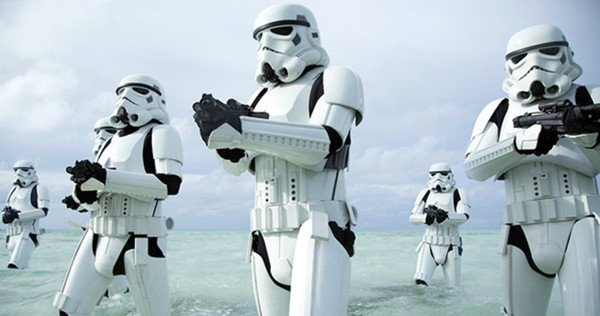
by Drew Howerton, section editor
This review contains very minor spoilers for Rogue One. Read at your own risk.
Sitting on my living room floor at age six, there was nothing more awe-inspiring than the opening of the original Star Wars. The thunderous roar of John Williams’ opening theme. My dad reading to me, “It is a period of civil war…” as the opening crawl rolled down my television screen. Suddenly, a fade to black, followed by slow roll down to a planet. Princess Leia’s starship rushing into view, pursued by Darth Vader’s powerful and cruel Star Destroyer, guns blazing. The hopeless eyes of Rebel soldiers as they are assaulted by stormtroopers, giving a grand entrance to Vader himself, shrouded in mystery and smoke.
At the ages of both six and the age of sixteen, the opening of Star Wars has never failed to give me chills. But every time I watched Star Wars, I had so many questions that for years went unanswered. Where did Princess Leia’s ship come from? Why was she given the plans to the Death Star by Rebel spies? And most importantly: how did the Rebel Alliance manage to capture the plans in the first place?
Rogue One: A Star Wars Story serves to answer these questions, as well as introduce younger audiences to the Star Wars franchise and give hardcore fans like myself an enhanced look at the universe we know and love. But more than just answer questions, Rogue One proves that the Star Wars name is in good hands.
Directed by Gareth Edwards, Rogue One takes place almost immediately before Star Wars Episode IV: A New Hope. In A New Hope, the Rebel Alliance is locked in an epic struggle with the evil Galactic Empire. The Empire has just completed construction on the Death Star, a massive space station capable of destroying an entire planet. However, Rebel spies have obtained the schematics to the Death Star in order to mount a last ditch offensive against the Empire. While this is all pretty straightforward in A New Hope, we are never given any explanation of where the plans came from or who the heroes who secured them were. Rogue One tries to fill in these holes by telling the story of the spies who stole the Death Star plans, as well as zoom in on the universe of Star Wars, and it succeeds on every account.
When her father Galen Erso (Mads Mikkelsen) is whisked away by the Empire and forced to help construct the Death Star, Jyn Erso (Felicity Jones) is cared for by radical Rebel Saw Gerrera (Forest Whitaker), fighting against the Empire throughout her youth, until she is arrested by the Empire. However, when Imperial pilot Bodhi Rook (Riz Ahmed) is given a message for Saw from Galen, he defects at Galen’s request to give Saw a message, containing information vital to the theft of the Death Star plans. The Rebel Alliance gets wind of this, and breaks Jyn out of Imperial custody in hopes that she will be able to convince Saw to help the Rebel cause. Jyn and Captain Cassian Andor (Diego Luna) go to find Saw, aided by reprogrammed Imperial droid K-2SO (Alan Tudyk). In their search for Saw Gerrera, Cassian and Jyn are joined by Chirrut Îmwe (Donnie Yen), a blind warrior who believes strongly in the Force, and Baze Malbus (Jiang Wen) a Rebel warrior and mercenary who travels with Chirrut. After meeting with Saw, the gang of Rebels decide to travel to the tropical planet of Scarif, an Imperial stronghold where all records, including the Death Star plans, are held. All the while, the Rebels are pursued by the evil Director Orson Krennic (Ben Mendelsohn), who oversees the construction of the dreaded space station.
Rogue One is at its strongest when it explores the unknowns of the original trilogy while staying true to the main series films. Everything from sets to music is packed with nostalgia, like the iconic Death Star alarm sounds, or the 70’s aesthetic of the Rebel pilots with their mustaches and clunky flight suits. There are a lot of hidden gems for long time fans to find, like Rebel pilots from A New Hope making an appearance in a large space battle at the end. Although not scored by legendary composer John Williams, Rogue One boasts a solid soundtrack that stands on its own alongside classic music from the original films, and when musical cues from the original are used, they are well timed. However, the nostalgia factor is played just right, and when the film does do fan service, it’s done with care and makes sure not to overdo it. Rogue One proves that you can teach an old dog new tricks, by taking details fans know and love and showing them from a different point of view. We are shown familiar locations like the Rebel base on Yavin 4, but are given a new look inside as we see characters like Rebel leader Mon Mothma in their humble beginnings. In Galen Erso’s message to Jyn, he explains the Death Star’s primary weakness and how to exploit it: a single shot to the main reactor will cripple the entire system. The Death Star’s massive weakness is a much discussed plot point amongst fans, but in the movie it is explained that the weakness is Galen’s doing, as revenge against the Empire for tearing him away from his daughter. Rogue One expands on a relatively small detail of A New Hope, adding new depth to the originally black and white struggle of A New Hope, and it is moments like these that make Rogue One a great addition to the Star Wars franchise. Not only that, but by adding detail to the lore of the series, Rogue One makes the original films even more enjoyable to watch.
Despite Rogue One being full on fan service at times, it never overshadows the original content of the film. Cameos from minor characters are very brief, making sure to let the new characters shine in their own right. Familiar locations like Yavin 4 may be important settings in the film, but new planets like the wartorn Jheda or the tropical Imperial stronghold of Scarif are the main backdrops of the film. Rogue One does a fantastic job of having an original story that distinguishes itself from other entries in the series while still setting the stage for the original trilogy films.
Easily the weakest point of the film is the character development, and characters in general. While every actor gives a solid performance in the movie, characters feel like they exist to simply push the plot forward instead of existing as their own entities. Diego Luna’s Cassian Andor is a prime example of this. At one point while being imprisoned, Chirrut Îmwe says to Cassian that he “carries his prison with him”, noting his hard outer exterior. Instead of exploring Cassian’s background, we only get a vague line about how he has been in the Rebellion all his life, and the rest of his story is largely ignored. Others, like Chirrut Îmwe and Baze Malbus get pushed to the side for portions of the film, although when they are on screen their performances are some of the best in all of Star Wars. Characters have only minimal development when they have any at all, and any development is given through dialogue that reads like fanfiction in some cases. Rogue One’s main villain, Orson Krennic is hard to dislike because only once or twice in the film is he shown to be really evil. However, his characterization is interesting because in a way, he is just as oppressed by the Empire as the other characters in the film. The droid K-2SO is meant to be a comedic relief character, and mostly succeeds in relieving some of the tension in the film, although Alan Tudyk’s lines felt a bit shoehorned in at times. I will say though, that K-2SO is the kind of comedy character that Jar-Jar was supposed to be.
Another thing that I had problems with was overall pacing. Rogue One initially has trouble in the first thirty minutes as it still figures out what to do with the characters it’s given us, jumping around from plot point to plot point in an effort to get the story going. In the middle, the story starts to pick up and characters do kind of find a voice, and there are legitimate moments that shine, like the Rebel crew’s decision to fight the empire, or Jyn’s eventual reunion with her father. However, the last third of the film is hands down the best part of the movie, with all of the plot points converging in a huge space and land battle as the Rebels try to steal the Death Star plans, quenching my thirst for a big space battle with X-Wing fighters duking it out with TIE fighters. Overall, Rogue One’s story has trouble finding a foothold, but once it does, the film delivers some of the best moments in all of Star Wars.
For the most part, Rogue One looks amazing visually. The sets are beautifully crafted, and blend seamlessly with the computer-enhanced scenery of space battles and small scale conflicts. The film is grittier than most Star Wars films, stylized heavily to evoke feelings of Vietnam war movies. Costuming is one of the strongest visual parts of the film. Rebel pilots are wearing accurately 70’s neon flight suits, and stormtrooper armor still looks clunky and unsafe as ever, while new characters wear outfits that fit the lived-in universe of the original films. My only complaint about visuals is the CGI recreation of Grand Moff Tarkin. In A New Hope, Imperial governor Tarkin is portrayed by Peter Cushing, who died in 1994. For Rogue One, Cushing was digitally recreated to portray the role of Tarkin once more. While it’s cool in concept, the execution leaves a lot to be desired, and I cringed whenever he was on screen because computer technology has not quite advanced to the point where we can recreate near perfect human faces.
Rogue One is an ambitious first attempt at a standalone Star Wars film. Is it as iconic as the original films? Not really, but that’s because it manages to place itself in a category of it’s own. As the first non-episodic movie in the series, Rogue One can do things that the main series films can’t, which is put the Star Wars universe under a magnifying glass and explore the finer details. Disney has shown its ability to care about Star Wars fans, tell a good story, and sell a lot of toys in the process (not going to lie, after the movie I went out and spent $30 on a Star Wars Lego set). I would say that I probably liked Rogue One just a bit more than The Force Awakens, although that could change. For now, i’m placing Rogue One number three in my list of favorite Star Wars movies: just behind A New Hope and my all time favorite The Empire Strikes Back. Despite pacing issues and problems with character development, Rogue One manages to stand by itself and make for an overall solid entry in the franchise.
Rogue One: A Star Wars Story is now playing in RealD, 3D and IMAX 3D.


Pingback: Rogue One: A Star Wars Story review – you used to be alright.